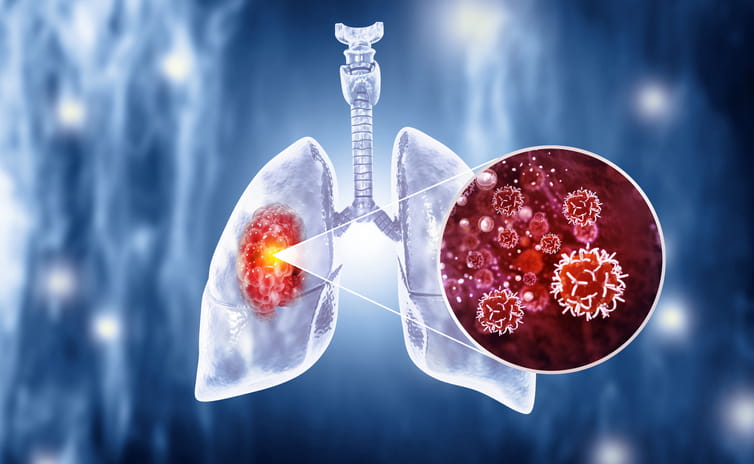
Each year, 20% of all cancer fatalities are attributed to lung cancer. Experts project that approximately 125,070 people will die of lung cancer in 2024, which is almost three times the number of car accident fatalities (42,514) in 2022.
Five years after their diagnosis date, less than 20% of those with lung cancer are still alive.
Since this disease is so deadly, early detection of lung cancer is crucial. Recognizing risk factors for lung cancer and common symptoms of the disease can prompt you to take appropriate steps to identify and treat lung cancer in the earliest stages. Let’s examine risk factors and early symptoms of this disease, the benefits of lung cancer screening, and how a CT scan for lung cancer can increase your survival rate.
Schedule your CT scan.
What Are The Early Symptoms Of Lung Cancer?
A persistent cough that does not improve is a common symptom of lung cancer. Since lung cancer impacts your ability to breathe, other common early symptoms include the following:
- Coughing blood
- Loss of appetite
- Pain when breathing
- Pain when coughing
- Persistent fatigue
- Recurring chest infections
- Unexplained weight loss
Symptoms that aren’t as common include dysphagia, persistent shoulder pain, and swelling in your face and neck.
Common and uncommon symptoms may not emerge until you’re past the earliest stages of the disease.
How Is Lung Cancer Diagnosed?
Preventative health scans are the most common and effective way to screen for lung cancer. Preventative health scans include the following:
- Computed tomography (CT) scans
- Magnetic resonance imaging (MRI) scans
- Positron emission tomography (PET) scans
Imaging tests enable your doctor to get a look inside you, and the scans reveal the location and size of tumors in your lungs.
It’s also possible to check your sputum for lung cancer cells to confirm a diagnosis. In some cases, doctors order a biopsy, which involves removing tissue for examination. Sometimes, a biopsy is performed after confirming the presence of a tumor to confirm it’s cancerous.
What Are The Different Types Of Lung Cancer?
The following are the different types of lung cancer:
- Lung nodules
- Mesothelioma
- Non-small cell lung cancer
- Small cell lung cancer
When lung nodules are cancerous, they typically spread to the lungs from another part of the body. Asbestos causes mesothelioma, and cigarette smoking causes most cases of small-cell lung cancer.
The following are the three primary types of non-small cell lung cancer:
- Adenocarcinoma
- Large cell carcinomas
- Squamous cell carcinoma
What Are The Most Common Risk Factors For Lung Cancer?
Common lung cancer risk factors include the following:
- Age
- Air pollution
- Asbestos exposure
- Diet
- Exposure to carcinogens
- Genetics
- Radiation therapy
- Radon exposure
- Respiratory disease
- Smoking
How Does Smoking Affect Lung Cancer Risk?
Smoking is the biggest risk factor, accounting for 70% of lung cancer cases. One reason is that smoking can mutate your DNA, causing cancerous growths. Cigarettes also contain harmful chemicals that cause cancer. Since you’re breathing those chemicals in when smoking, they enter your lungs, increasing the risk of lung cancer.
Can Non-Smokers Develop Lung Cancer?
Non-smokers can get lung cancer. Some people are genetically predisposed, and exposure to second-hand smoke, radiation, radon, and other chemicals can also cause lung cancer.
Genetics And Your Risk Of Lung Cancer
Mutated genes can cause lung cancer, and mutated genes can pass through bloodlines. Consequently, a family history of lung cancer increases your risk of getting the disease.
Related: Cancer Rates Among Construction Workers
What Lifestyle Changes Can Help Prevent Lung Cancer?
Some of the most effective ways to lower your risk include the following:
- Dietary changes: Eat cancer-fighting fruits and vegetables and other foods known to fight cancer. Popular cancer-fighting foods include the following:
- Berries
- Broccoli
- Eggs
- Grapes
- Lean chicken
- Lean turkey
- Oatmeal
- Salmon
- Tomatoes
- Walnuts
- Wild rice
- Eliminate exposure to chemicals and second-hand smoke: Avoid careers and activities that involve exposure to carcinogens and cancer-causing chemicals.
- Exercise: Cycling, dancing, lunges, running, and swimming are aerobic exercises for reducing lung cancer risk.
- Quit smoking: Quitting smoking is the most effective way to reduce your chances of getting this disease because it’s the most common cause of lung cancer. You can use aids to help you quit or talk to your doctor and get medical help to break your habit.
Maintaining a healthy weight is another way to lower your risk of lung cancer.
Are There Any Screening Tests Available For Lung Cancer?
A lung scan is the most effective way to identify lung cancer during its earliest stages. Lung cancer screening in Las Vegas enables you and your doctor to look inside your lungs.
If you’re a current or former smoker over 50 with a family history of lung cancer, an annual lung cancer screening will give you peace of mind by ensuring you’re aware of your health status and get the earliest possible treatment if you develop this disease.
At Preventative Diagnostic Center, we offer CT lung scans that will give you a clear image of your lungs and confirm if you’re cancer-free. You do not need a doctor’s referral, and our noninvasive CT scans are quick and thorough, ensuring you get the answers you need promptly.
